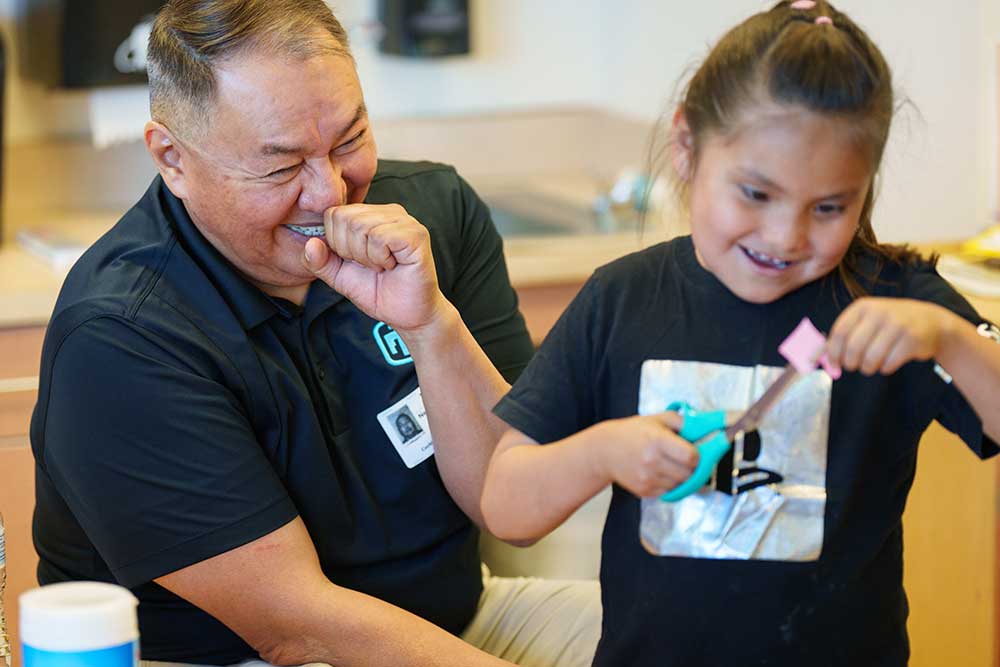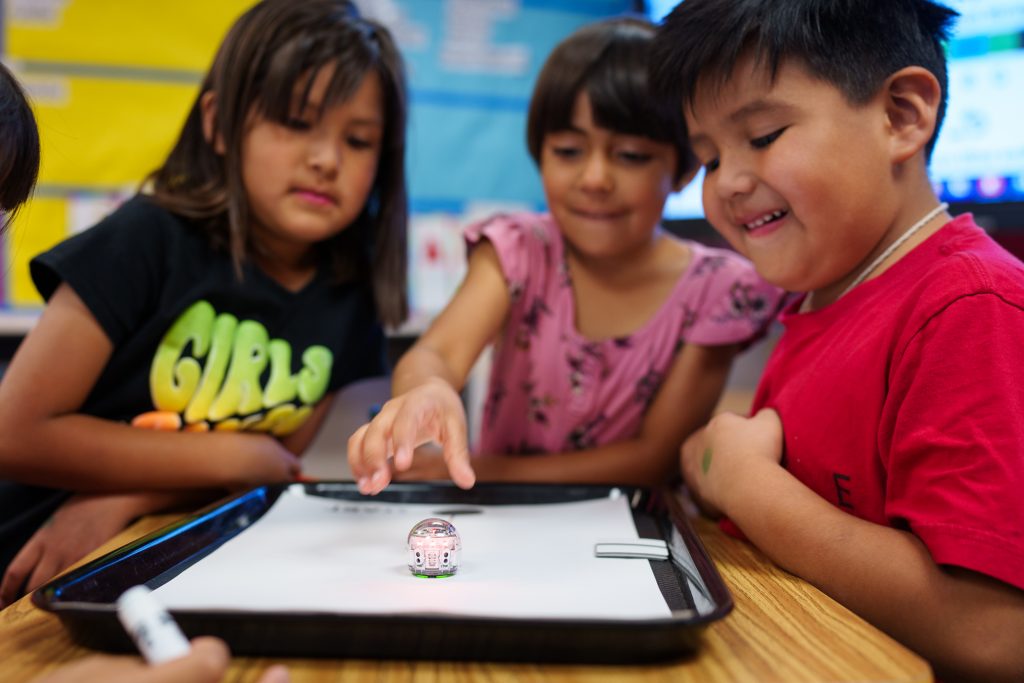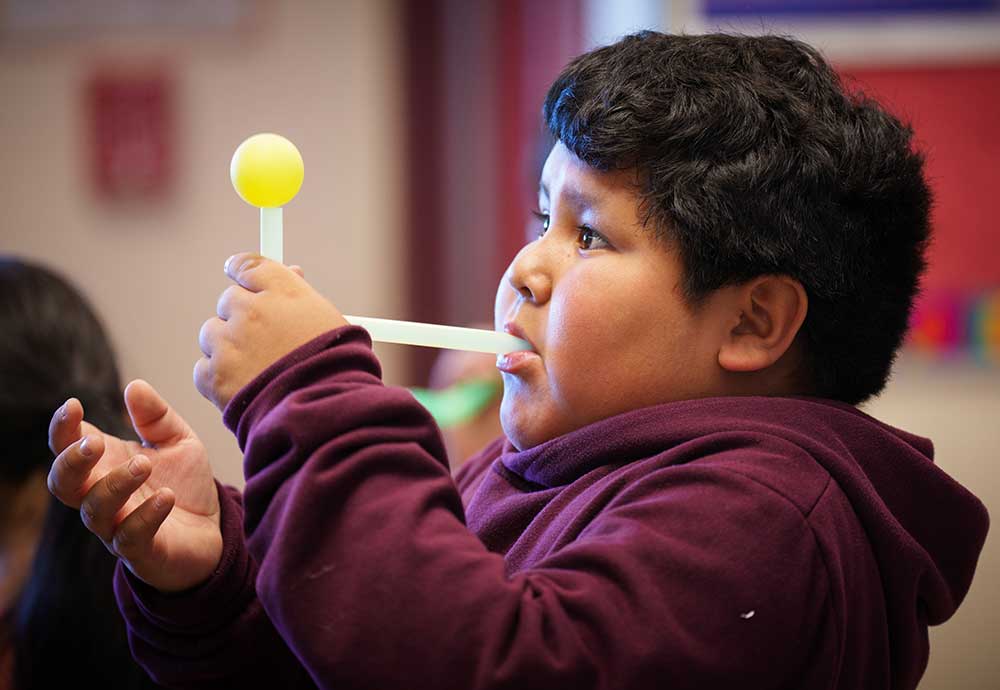Sandia holds STEM Day at Cochiti Pueblo
NERVOUS EXCITEMENT — Cochiti Elementary School students cheer on GIZMO, Sandia’s robotic dog, as it jumps and dances. (Video by Craig Fritz)

I was fascinated as a little kid on the reservation, just looking up at the sky and seeing airplanes fly,” engineer Nelson Morez said to a group of first graders at Cochiti Elementary School. “I was amazed at how something so heavy was able to stay up there.”
Nelson, a systems engineer at Sandia, and proud member of the Dinè reservation, grew up much like these kids. As part of STEM Day, he joined a team of about a dozen volunteers from Sandia who visited the school on the Cochiti Pueblo.
“I love it; it really takes me back to my childhood,” Nelson said. “I want to explain to them the things I wish I knew at that age. They are all very inquisitive and quick learners. Growing up on the reservation, at my school, none of this happened.”
Nelson spent the day explaining Bernoulli’s Principle, a fundamental concept in fluid dynamics regarding pressure, speed and height. While the students may not remember the famous physicist it is named after, Nelson hopes they will remember the fun they had blowing a ball off a straw and out of a cylinder, demonstrating how different dynamics affect flight.
That is the purpose of STEM events like this one: students engaging in fun activities that teach basic science, technology, engineering and math skills.
“Would you like to build a lava lamp?” asked Debra Menke, STEM Outreach Program Manager. “Yeah!” said the kids, unaware that they were about to learn about chemical reactions.
“Look at mine. It’s perfect,” first grader Albert Thomas said while showing off his dark-green lava lamp.

The students also explored computer programming using Ozobots. Each student drew a multicolored path on a piece of paper and watched the tiny robot follow it. Some wrote their names and watched it follow each curve and giggled or shook their heads when the robot made a wrong turn. “Oh no, where is that little guy going?” asked one student.
Another Sandia volunteer taught students how to build a basic circuit board, while others guided them in exploring structural engineering using spaghetti and marshmallows.
With the support of volunteers from Los Alamos National Lab and the Pajarito Environmental Education Center, students also had the opportunity to fly drones, build rockets and learn about birds and wildfires.
But the most popular attraction was GIZMO, Sandia’s robotic dog.
As the gray, faceless machinery made its way down the school sidewalk, walking like a four-legged animal, high-pitched screams filled the air. For kids who stood just a few feet tall, it was intimidating at first. Soon, the kids grew more comfortable and excited to touch the robot.
“Who wants to shake his hand?” Deb asked, prompting a sea of raised hands from excited kids. Some even jumped up and down to be recognized. Deb said GIZMO can be deployed in dangerous situations and detect hazards like radiation and gas leaks, patrol perimeters and test detection devices, or communicate with people in the area.
The kids though, were more captivated by GIZMO’s ability to jump, wiggle and show love, forming his “paws” into the shape of a heart. The encore was accompanied by a little music. “Who wants to see him dance?” Deb asked, which set off squeals of excitement and a dance party with GIZMO.

Educators and Sandia volunteers hope that the students remember events like this when they look back on their education and toward their future.
“I think it’s really important for them to experience things like this because it broadens their horizons,” teacher Melanie Harris said. “It exposes them to new things, and it encourages them to dive into worlds they might not know.”
Nelson was happy to be a part of it. “I am Native, so I really enjoy coming back to Native communities to share my path.”
His path included a career in the U.S. Navy supporting various aircraft electronics and flight test platforms. Nelson also served as a U.S. Naval Reserve Aircrewman Operator before working for Boeing, Lockheed Martin, Honeywell Aerospace and Bombardier prior to joining Sandia.
But his interest in aircrafts started in childhood.
“When I was a kid, I made a decision that one day I would learn how aircrafts fly, how they stay aloft,” he said. “I was able to fulfill that in a lifelong dream. Now I am able to give back and hopefully inspire young minds.”